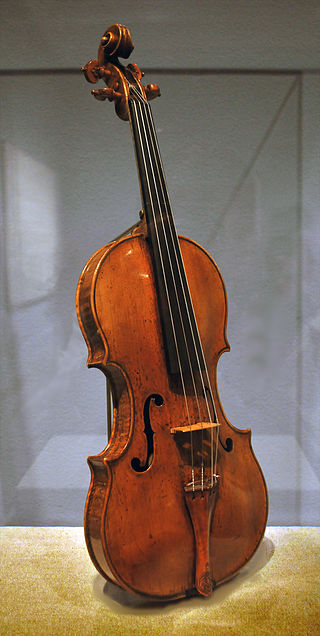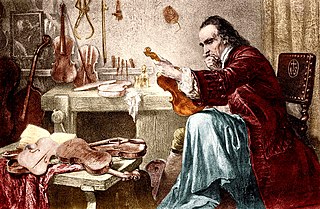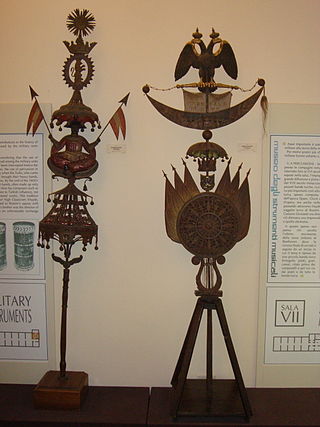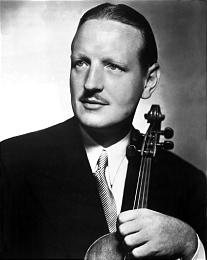The Medici tenor viola is a notable tenor viola by Antonio Stradivari. It is part of a set of instruments by this luthier which belonged to the Grand Dukes of Tuscany. [1] [2]
Contents

The Medici tenor viola is a notable tenor viola by Antonio Stradivari. It is part of a set of instruments by this luthier which belonged to the Grand Dukes of Tuscany. [1] [2]

The instrument was made in Cremona in 1690, and so far as is known, it has remained in Tuscany since it was delivered to the Medici court. The ruler at the time was Cosimo III de' Medici, but it was his son, Ferdinando de' Medici, Grand Prince of Tuscany, who was known for his patronage of music.
It is in exceptional condition, which probably indicates that there has been relatively little demand to play an instrument of this type. In Stradivari's time violas came in two sizes, tenor and alto. Tenor violas have become largely obsolete, whereas alto has become the standard voicing for violas. There were originally two violas in the Medici set, the other being an alto: the two instruments appear to have become separated in the late 18th century.
Since the 19th century the tenor viola has belonged to Florence's conservatory, the Conservatorio Luigi Cherubini, which acquired a collection of musical instruments from the time of the Grand Duchy of Tuscany. In an inventory made by the conservatory in 1863 the instrument was given a value of only £1,000, whereas the cello from the same set was valued at £7,000. [3]
The instrument has a two-piece back made from maple and the belly is of spruce. [3] It is decorated with the Medici crest in mother-of-pearl on the fingerboard and a cupid on the tailpiece. [3]
The tenor viola is on display in the Museo degli strumenti musicali, accessed via the Galleria dell'Accademia, [4] which is best known as the home of Michelangelo's David. [5]
The set of instruments in Madrid known as the Stradivarius Palatinos originally included a tenor viola.

Amati is the last name of a family of Italian violin makers who lived at Cremona from about 1538 to 1740. Their importance is considered equal to those of the Bergonzi, Guarneri, and Stradivari families. Today, violins created by Nicolò Amati are valued at around $600,000. Because of their age and rarity, Amati instruments are mostly kept in museum or private collections and are seldom played in public.

Antonio Stradivari was an Italian luthier and a craftsman of string instruments such as violins, cellos, guitars, violas and harps. The Latinized form of his surname, Stradivarius, as well as the colloquial Strad are terms often used to refer to his instruments. It is estimated that Stradivari produced 1,116 instruments, of which 960 were violins. Around 650 instruments survive, including 450 to 512 violins. His instruments are considered some of the finest ever made, and are extremely valuable collector's items.

A Stradivarius is one of the violins, violas, cellos and other string instruments built by members of the Italian family Stradivari, particularly Antonio Stradivari, during the 17th and 18th centuries. They are considered some of the finest instruments ever made, and are extremely valuable collector's items.

Giovanni Battista Guadagnini was an Italian luthier, regarded as one of the finest craftsmen of string instruments in history. He is widely considered the third greatest maker after Antonio Stradivari and Giuseppe Guarneri "del Gesù". The Guadagnini family was known for their violins, guitars and mandolins.

The Paganini Quartet was an American string quartet founded by cellist Robert Maas and violinist Henri Temianka in 1946. The quartet drew its name from the fact that all four of its instruments, made by Antonio Stradivari (1644–1737), had once been owned by the great Italian violinist and composer Niccolo Paganini (1782–1840).

The Messiah - Salabue Stradivarius of 1716 is a violin made by the Italian luthier Antonio Stradivari of Cremona. It is considered to be the only Stradivarius in existence in as new state. It is in the collection of the Ashmolean Museum in Oxford, England.
The Kopelman Quartet is a Russian string quartet founded in 2002 by Mikhail Kopelman (violin), Boris Kuschnir (violin), Igor Sulyga (viola) and Mikhail Milman (cello). They studied at the Moscow Conservatory in the 1970s, but pursued individual careers for twenty-five years before founding the quartet.

Bartolomeo Giuseppe "del Gesù" Guarneri was an Italian luthier from the Guarneri family of Cremona. He rivals Antonio Stradivari (1644–1737) with regard to the respect and reverence accorded his instruments, and for many prominent players and collectors his instruments are the most coveted of all. Instruments made by Guarneri are often referred to as Del Gesùs.

A tenor violin (or tenor viola) is an instrument with a range between those of the cello and the viola. An earlier development of the evolution of the violin family of instruments, the instrument is not standard in the modern symphony orchestra. Its tuning, typically G2-D3-A3-E4 (an octave below the regular violin) places the range between the cello and viola and thus is sometimes confused with the modern baritone violin which has the same tuning on the standard violin body.
The Hellier Stradivarius of c. 1679 is a violin made by Antonio Stradivari of Cremona, Italy. It derives its name from the Hellier family, who might well have bought it directly from the luthier himself.
The Baron Knoop, ex-Bevan Stradivarius is a violin made by the celebrated luthier Antonio Stradivari in Cremona, Italy in 1715.

The Accademia Nazionale di Santa Cecilia Musical Instruments Museum (MUSA) is the museum holding the instruments collection of musical instruments of the Accademia Nazionale di Santa Cecilia.

Nicola Amati, Nicolò Amati or Nicolao Amati was an Italian master luthier from Cremona, Italy. Amati is one of the most well-known luthiers from the Casa Amati. He was the teacher of illustrious Cremonese School luthiers such as Andrea Guarneri and Giovanni Battista Rogeri. While no clear documentation exists for their being apprentices in his shop, Amati may also have apprenticed Antonio Stradivari, Francesco Rugeri, and Jacob Stainer, as their work is heavily influenced by Amati.

Count Ignazio Alessandro Cozio di Salabue (1755–1840) was an Italian nobleman who was known as the first great connoisseur and collector of violins. A trove of correspondence and memoirs on the history of violinmaking known as the Carteggio forms the basis of his biography. Cozio's meticulous notes on nearly every instrument that passed through his hands contributed enormously to the body of knowledge surrounding Italian violinmaking.

The Violin Museum is a musical instrument museum located in Cremona. The museum is best known for its collection of stringed instruments that includes violins, violas, cellos and double basses crafted by renowned luthiers, including Antonio Stradivari and Giuseppe Guarneri del Gesù.
Vincenzo Rugeri, was an Italian luthier of string instruments such as violins, cellos, and, violas in Cremona, Italy. His instruments are noted for their craftsmanship and tone quality. Vincenzo came from a distinguished family of luthiers, the first of whom was his father, Francesco Rugeri. Despite the local tradition of artisan families laboring together through generations, Vincenzo left the family shop and set up a successful shop of his own in the center of Cremona. Vincenzo was the third son of luthier Francesco Rugeri. Vincenzo's work, like Francesco's, is influenced by Nicolò Amati's Grand Pattern model, however Vincenzo's work was distinguished from his father's by utilizing a lower arch inspired by Antonio Stradivari. An analysis of the body of his work reveals that the quality of Vincenzo's instruments is remarkable, perhaps even more so than his father's. Vincenzo's instruments, though less numerous, are valued at least equal to those of his father. A violin by Vincenzo Rugeri realized $502,320 on October 3, 2011 at Brompton's Auctions in London. Carlo Bergonzi was a distinguished apprentice of Vincenzo Rugeri.

The Stradivarius Palatinos are a set of five string instruments made by Antonio Stradivari around 1700. They are kept in Madrid's Royal Palace. The term "Palatino" can in this case be translated as "court" instruments, as it refers to their belonging to the Spanish royal collection.

The "ex-Primrose" is an antique viola named after the viola player William Primrose who purchased it in 1954. This late 17th-century instrument is one of seven known Guarneri family violas.